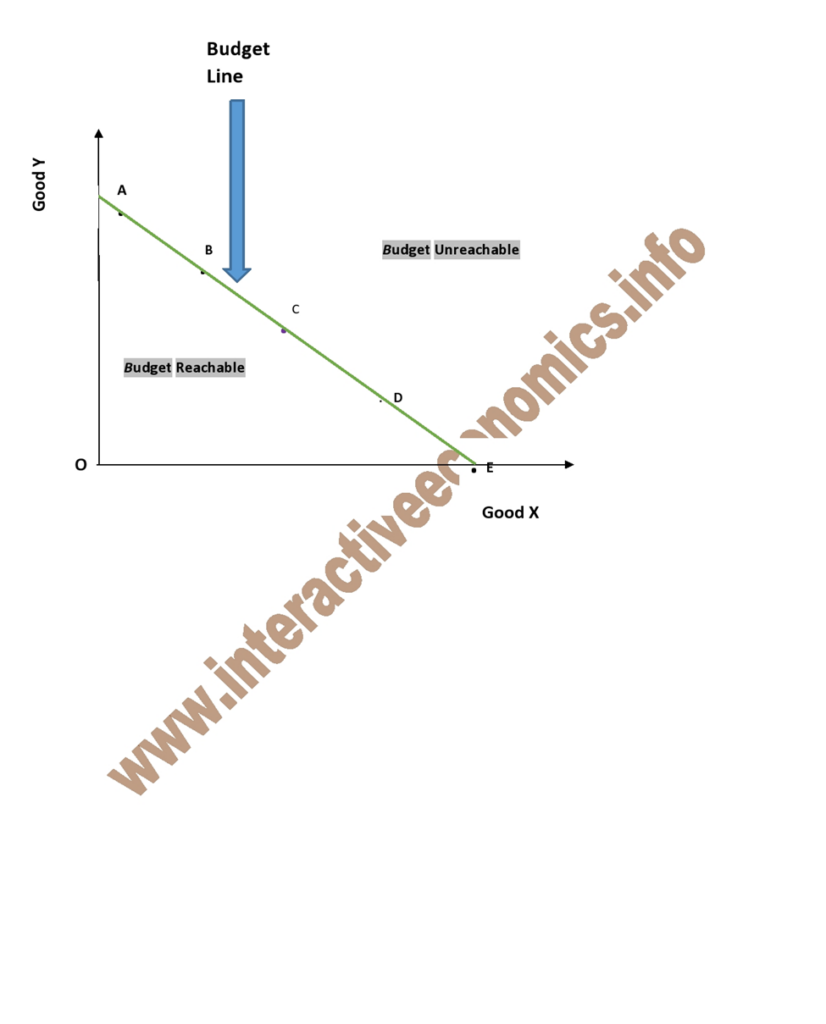
Budget Line/Budget Constraint
The budget line, sometimes referred to as the budget constraint, displays every combination of two commodities that a consumer is able to afford at the current market price and within their specific income range.
The budget line is a graphical representation of every combination of the two commodities that could be purchased using the given income and cost, with the price of each combination being equal to the customer’s monetary earnings.
It’s critical to remember that the slope of the budget line corresponds to the price ratio of two commodities. The slope of the budget constraint is very significant.
In other words, the budget line’s slope may be characterised as a straight line that bends downwards and covers all possible combinations of the two commodities that a consumer can acquire at market value by allocating his or her full salary. The budget line is not the same as the Indifference curve, although both are required for consumer equilibrium.
Budget Line Equation
A budget line is also known as a budget constraint because, while a consumer strives to maximise utility throughout the indifference curve, he or she is constrained by two extremely strong constraints: commodity market prices and limited income.
Income is a key constraint since there is only a certain height in the indifference curve that can be attained given the income. This budgetary constraint is reflected in the budget line equation below.
PxX Qx+PyXQy=Y
Where,
Px= Price of Commodity X
Py= Price of Commodity Y
Qx= Quantity of Commodity X
Qy= Quantity of Commodity Y
Y = Consumer’s income
The above equation indicates that a consumer’s expenditure for acquiring commodities X and Y can never exceed his or her income (Y).
Features /Properties of Budget Line
The budget line’s characteristics or attributes are listed below.
Real Income Line
The real income line is determined by an individual’s income and expenditure capacity.
Straight Line
The straight line in the budget line represents the current market exchange rate for each combination listed.
Negative Slope
The budget line’s negative downward slope demonstrates the inverse link between the purchasing of two goods.
For instance, suppose A and B are two items that must be acquired in 20 units each with a Rs.400 budget. If 25 units of A are ordered, only 5 units of B are available. This is because revenue remains constant at Rs.400.
Indifference Curve Tangent
The indifference curve establishes consumer equilibrium when it hits the budget line.
Assumptions of Budget Line
As we all know, economics is primarily built on assumptions, and the same is true for the budget line. In order to make the results and analysis more obvious and understandable, the economist assumes the following in relation to a budget line:
Two Products:
It is thought that the consumer would spend his or her whole salary on only two products.
Consumer Income is Known:
The consumer’s income is restricted and known, and the money is entirely devoted to purchasing only two products.
Market Pricing is Known:
The consumer is aware of the market price of both products.
Expenditure equals income:
We assume that the consumer spends his or her entire income.
Shift/Movement in Budget Line:
The following elements influence budget line consistency:
1) Consumer income
2) The two commodities’ prices
3) The quantity of the two products bought
While the consumer has some influence over the quantity of goods purchased, the price and consumer income alter over time. This change is what causes the budget line to alter.
Impact of Income Change: A reduction in income indicates a reduction in purchasing power, and vice versa, leading the budget line to change.
The Impact of Price Change: Commodity prices are volatile, and they are inversely proportional to consumer purchases. If product prices decline, it is likely that more of them will be bought.
Budget Line Premises:
1) Determination of Commodity Market Prices
The budget line presupposes that the consumer will always be aware of the market pricing of the two commodities under consideration. Any changes in that regard will render the line infeasible.
2) Data on Consumer Income
It is assumed that the consumer’s income is restricted and accurate. Furthermore, resource allocation is only done for a known number of goods.
3) Commodity Quantity
The notion of a budget line is founded on just two things. It presupposes that a consumer’s demand will be strictly confined to two goods and no more. It is understandable that this is not the case.
Slope of Budget Line
What causes a budget line to slope downward?
Given that the consumer has a fixed income, he or she must forego some amount of Goods Y in order to get an additional unit of Goods X.
This inverse connection between the two commodities results in a decreasing slope.
Please see the preceding example for a practical explanation of a downward sloping budget line.
Shift in Budget Line
A budget line is made up of the consumer’s income, the price of the products, and the amount bought. The amount of goods is a controlled agent in this case, but the other two may fluctuate over time.
As a result, it deviates from its initial position for the following two fundamental reasons:
1. Shift due to Change in Price:
Commodity prices are dynamic and fluctuate from time to time. The market value of the products will either fall or rise.
If the other parameters, such as income and the price of products Y, remain constant, and the price of one product, say X, falls, the consumer’s purchasing power for goods X rises automatically.
If all other conditions stay constant, and the price of good X rises, the consumer’s purchasing power for product X falls automatically.
2. Shift due to Change in Income:
Income is another important factor that influences budget line.
A rise in the consumer’s income indicates an increase in his or her purchasing power, and vice versa, resulting in a change in the budget line.
